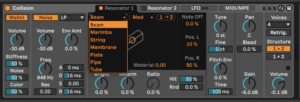Collision: Sound Design with Resonant Objects
Collision: Exciters and Resonators
Collision is a physical modeling synthesizer in Ableton Live that simulates the behavior of different resonant objects, allowing for the creation of percussive and blown sounds. It has two main components: the resonator and the exciter.
The resonator is modeled as a resonant body with different physical characteristics, such as size, shape, and material. The exciter is what drives the resonator and creates the initial sound that gets filtered and resonated by the resonator.
Two different types of exciters can be used in Collision: mallet and noise. Mallet excitation is ideal for creating percussive sounds, such as drums and marimbas, while noise excitation is better suited for blown sounds, such as flutes and pipes.

When using mallet excitation, the resonator is excited by a virtual mallet striking the body. The sound of the mallet hitting the body creates a short, sharp attack, which is then filtered and resonated by the body to create the final sound. By adjusting the physical characteristics of the resonator, such as its size, shape, and material, and by changing the properties of the mallet, such as its hardness and velocity, a wide range of percussive sounds can be created.
When using noise excitation, the resonator is excited by a burst of noise that simulates the sound of air being blown into a tube. This creates a more sustained, breathy sound that is then filtered and resonated by the body to create the final sound. By adjusting the physical characteristics of the resonator, such as its size, shape, and material, and by changing the properties of the noise burst, such as its frequency and amplitude, a wide range of blown sounds can be created.
In general, mallet excitation is better suited for creating percussive sounds with sharp attacks and short decay times, while noise excitation is better suited for creating blown sounds with more sustained tones and longer decay times. However, both types of excitation can be used creatively to create a wide range of sounds, and combining them can lead to interesting hybrid sounds.
Corpus
Corpus is a resonator-based effect in Ableton Live that can be used to add acoustic resonance to a sound. It can be used to enhance the natural resonance of an instrument or add an acoustic layer to synthetic sounds. It is basically the Resonator section of Collision, which we have studied in a previous lesson.To use Corpus, simply add it as an effect to an audio or midi track in Ableton Live and adjust the parameters to achieve the desired effect.

Here are some ways to use Corpus:
- Enhance drum sounds: Corpus can be used to add resonance and body to drum sounds. For example, you can add a punch to a snare drum or use it to add to tighten a kick drum or add sub to it..
- You can also use Corpus to add an acoustic layer to synth sounds.This will make them sound more unique and give them an acoustic sheen. Alternately you could also use to enhance the existing character of a synth patch.
- Enhance vocal and acoustic instrument recordings: You can use Corpus to enhance the natural resonance of vocal or piano.
You can adjust the resonator type, size, and positions where the vibrations are measured, as well make the sound more inharmonic. There is also a filter to fine-tune the harmonic spectrum and LFO for creating movement and variation in the sound.
Bleed mixes a portion of the unprocessed signal with the resonated signal. At higher values, more of the original signal is applied. This is useful for restoring high frequencies, which can often be damped when the tuning or quality are set to low values.
quality are set to low values.


